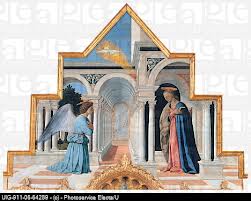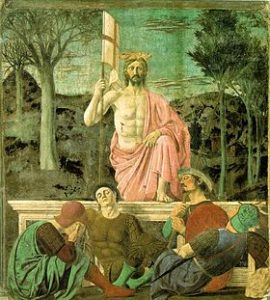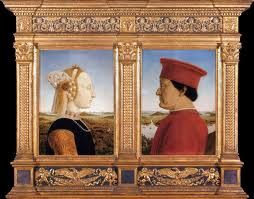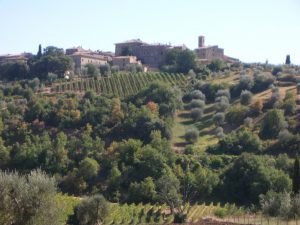Food and nostalgia aside, Philip and I also decided to pay homage to the Early Renaissance artist Piero della Francesca (c. 1412 -1492), born in nearby Sansepolcro, famed for his realism/humanism and his geometric accuracy, particularly for perspective. He was also made famous (in England, at least) by John Mortimer’s book ‘A Summer’s Lease’, in which the main character follows the renowned ‘Piero della Francesca Art Trail’. Philip and I had watched the film of this book during our first joint visit to Italy, which was also our first encounter of Piero’s work. My parents had in fact done the whole Piero trail and their subsequent enthusiasm further inspired us to do the same.
We started with the ‘The Polyptych of Perugia’ (also known as ‘Polyptych of St. Anthony’), which is a wonderful series of paintings that Piero completed around 1470. It is kept in the Galleria Nazionale del Umbria in Perugia, which in itself is a fascinating town that we had visited on our first trip together, so it was interesting to return.
Piero’s polyptych was painted for the Franciscan convent of Sant’Antonio da Padova in Perugia, and portrays Mary and baby Jesus in the centre, flanked by various saints in side panels. The top of the polyptych is the Annunciation, whose light-filled pastel shades and clean, crisp lines typify Piero’s style and also show his great ability to depict both humanism and architectural features. This piece is considered to be one of the best Renaissance art representations of perspective.
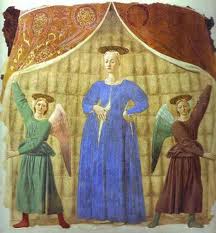 The next ‘Piero’ was located in the most unlikely of locations – a tiny village-like town called Monterchi, which appeared eerily abandoned with all the buildings securely shuttered during the Italian summer holiday. That is, all save a small museum which housed Piero’s ‘Madonna del Parto’ (Madonna with child) and a little oasis of a venue for our cherished espressos (see later). ‘Madonna del Parto’ (1465) was not in fact one of my favourite pieces on account of its rather sombre dark colours, and the fact that Mary and the two symmetrical angels are not particularly attractive nor in proportion with one another. Apparently, it was the traditional style of medieval art to portray Madonna larger in size than other human figures – this may be the case but, with or without this knowledge, it simply looks like the figures are mistakenly out of scale.
The next ‘Piero’ was located in the most unlikely of locations – a tiny village-like town called Monterchi, which appeared eerily abandoned with all the buildings securely shuttered during the Italian summer holiday. That is, all save a small museum which housed Piero’s ‘Madonna del Parto’ (Madonna with child) and a little oasis of a venue for our cherished espressos (see later). ‘Madonna del Parto’ (1465) was not in fact one of my favourite pieces on account of its rather sombre dark colours, and the fact that Mary and the two symmetrical angels are not particularly attractive nor in proportion with one another. Apparently, it was the traditional style of medieval art to portray Madonna larger in size than other human figures – this may be the case but, with or without this knowledge, it simply looks like the figures are mistakenly out of scale. After the museum, we strolled around Monterchi, which was in fact a very attractive hill town, aside from its deserted ambiance. We had resigned all hope of finding a café for our regular morning treat, when I (forever the optimist) asked a solitary gentleman who pointed towards a tiny little street, where we discovered an insignificant ‘tabaccaio’ (tabac) ‘hiding’ behind a couple of plastic chairs. We were pleasantly surprised by the quality of the coffee served in this whimsical setting, further confirming our faith in Italian coffee’s consistently high standard, regardless of location.
This was to be a rather ‘Piero-packed’ day, as we also visited his birthplace, Sansepulcro, after a very pleasant picnic lunch in the Italian hillside. We sat amongst the trees in what would have been the extensive grounds of an extremely attractive Tuscan casa, which was now deserted and ripe for renovation. The red and white stripe design on the exterior walls of the house gave it an ecclesiastical noble air, rendering the whole building and setting rather enchanting.
Back to Piero and Sansepulcro, which was a relatively large town but equally quiet, especially as we had arrived during siesta time. We walked around the attractive winding streets to find the museum in the 14th century Palazzo Comunale. It was strange to find so few people visiting such renowned works of art, but it made it all the more pleasurable to have a semi-private viewing of such wonderful pieces, giving us the time to admire and study them in detail. The most famous exhibit in this location is ‘The Resurrection’ (1463) in which a resurrected Jesus Christ stands behind four sleeping soldiers. Once again, the colours are rather sombre except for Christ’s naked body, partly covered by a peach robe, from which light radiates. The soldiers are in front of a Roman-style marble wall, which is juxtaposed by the wild, time-less forest behind Christ.
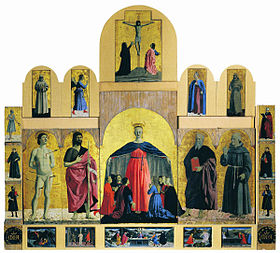 In the same room there was Piero’s polyptych of ‘Madonna della Misericordia’ (Madonna of Love and Kindness), which was one of Piero’s earliest works started in 1445 and completed in 1462 (when Piero was fifty – so hope for me yet!). This was a commission for the ‘Compagnia della Misericordia’ – a Christian confraternity (charity organisation) based in Sansepulcro. There were many specifications for the painting, one being that it had to be completed in three years; another was that it had to be in precious colours on a gilt background; and it also had to incorporate members of the confraternity. Piero obviously ignored the first stipulation, completing the work of art in a total of seventeen years (again, hope for me, as my perfectionist trait hinders quick results). It was rather difficult to paint on the gilt background, but Piero overcame this problem by ‘cheating’ a little on main/central panel, cleverly using Madonna’s cloak, painted in oil, as a backdrop to the kneeling members of the confraternity (once again, the confraternity are miniature/child-size figures relative to the Madonna).
In the same room there was Piero’s polyptych of ‘Madonna della Misericordia’ (Madonna of Love and Kindness), which was one of Piero’s earliest works started in 1445 and completed in 1462 (when Piero was fifty – so hope for me yet!). This was a commission for the ‘Compagnia della Misericordia’ – a Christian confraternity (charity organisation) based in Sansepulcro. There were many specifications for the painting, one being that it had to be completed in three years; another was that it had to be in precious colours on a gilt background; and it also had to incorporate members of the confraternity. Piero obviously ignored the first stipulation, completing the work of art in a total of seventeen years (again, hope for me, as my perfectionist trait hinders quick results). It was rather difficult to paint on the gilt background, but Piero overcame this problem by ‘cheating’ a little on main/central panel, cleverly using Madonna’s cloak, painted in oil, as a backdrop to the kneeling members of the confraternity (once again, the confraternity are miniature/child-size figures relative to the Madonna).
The pièce de resistance of our Piero tour was the ‘True Cross’ (1452-66) in the 13thcentury basilica of San Francesco in Arezzo (our Piero tour was in fact directed more by personal choice, than the guide books, our aim being to see as much as possible, particularly those of special interest). Our visit to the ‘True Cross’ was made all the more poignant by it being the first ever Piero that we had seen during our initial visit together (albeit under renovation at that time, so mostly covered in scaffolding). This stunning work of art also features in the film ‘The English Patient’ accompanied by Gabriel Yared’s film score. The scene is exceptionally romantic and should be seen to be appreciated – love and art conquers all in war-torn Italy:
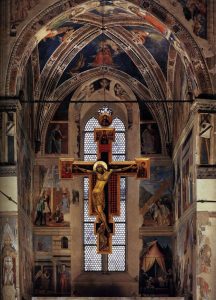 Back to our visit to marvel at Piero’s fresco-narration of ‘The True Cross’ adorning the walls of San Francesco’s apse chapel. Piero was commissioned to paint the Bacci family chapel relating the popular ‘Golden Legend’ of a 13th century monk, which is a very long detailed and digressive history of Christ’s wooden crucifix, from its origins linked to the death of Adam, up until its return to Jerusalem by the 7th century Emperor Heraclius.
Back to our visit to marvel at Piero’s fresco-narration of ‘The True Cross’ adorning the walls of San Francesco’s apse chapel. Piero was commissioned to paint the Bacci family chapel relating the popular ‘Golden Legend’ of a 13th century monk, which is a very long detailed and digressive history of Christ’s wooden crucifix, from its origins linked to the death of Adam, up until its return to Jerusalem by the 7th century Emperor Heraclius.Fact or fiction, I was simply mesmerised by the intricate frescoes painted in Piero’s palette of beautiful illuminating pastels, the clever expression of light and attention to architectural detail and perspective. I’m also fascinated by the way that artists of former times were strictly directed by their commissioners and hierarchy, as shown by the abstract inclusion of key characters of significance within paintings, as well as local countryside and towns; thus explaining why, in this case, Tuscany (including the town of Arezzo itself) is the setting for Roman battlefields and Jerusalem.
This was indeed a most memorable visit, made even more so by the fact that we had the whole apse chapel to ourselves (we had expected the contrary on account of the guidebook’s recommendation ‘to book in advance for a restricted viewing time’ – thankfully the guidebook had over exaggerated the effect of tourism, or perhaps we had the guardian angel of Piero by our side …?).
We were not quite so fortunate during our visit to Firenze (Florence), where we had pre-booked tickets for the Uffizi in the hope of seeing Piero’s ‘Duke and Duchess of Urbino’ (1460). However, in hindsight it all turned out for the best, that was, to end our Piero tour on a high note with what is renowned to be his most important surviving example of art – ‘The True Cross’. The carefully planned visit to the Uffizi had been scuppered by civil servants protesting in the streets for their rights, versus manning public institutions, such as the famous gallery. Their relatively calm, yet noisy, demonstrations added to the crowds of tourists and locals who seemed to have doubled in number since our last visit to Florence; this somewhat clouded our view, and also made for a rather exhausting tour, trying to find the hidden corners where we could avoid the masses. We did in fact manage to escape to little side streets that were familiar from previous visits, when we had stayed with Italian friends. We thus enjoyed our morning espresso in a tiny café in the company of charismatic Italians, followed by a meander through the streets via the antique and hand-marbled paper shops, and the exclusive haute couture boutiques such as Ferragamo, Bulgari, Gucci, Pucci, Roberto Cavalli and Prada in Via della Vigna Nuova and Via de’ Tornabuoni (all surprisingly devoid of tourists). We then went to the ‘Oltrano’ district (‘Oltrano’ literally meaning ‘across the Arno’) that I had first visited in 1993 in pursuit of a handbag from the rustic ‘leather district’, whilst staying in Florence with my Italian friend Chiara. The area had certainly changed over time – the small leather workshops had become smart, glass-fronted retail outlets with fine displays. I was somewhat disappointed, although I should selflessly congratulate the leather craftsmen on their success, that is, if the current owners are those tradesmen of old, or perhaps now their descendants.
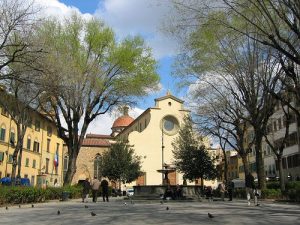 The simple facade of Brunelleschi’s Santo Spirito church (his last design before his death in 1446, which was completed posthumously), was much more in keeping with my memory of the Oltrano. We enjoyed a very pleasant lunch sitting in the relatively tranquil surroundings of the Piazza di Santo Spirito, where I could have sat all day, feeling tired after our active morning. However, our 2pm Uffizi appointment pulled us into action to skirt along the high walls of Palazzo Pitti’s Boboli Gardens (a ‘must’ for another time), followed by the stone facade of the palace and its grand entrance.
The simple facade of Brunelleschi’s Santo Spirito church (his last design before his death in 1446, which was completed posthumously), was much more in keeping with my memory of the Oltrano. We enjoyed a very pleasant lunch sitting in the relatively tranquil surroundings of the Piazza di Santo Spirito, where I could have sat all day, feeling tired after our active morning. However, our 2pm Uffizi appointment pulled us into action to skirt along the high walls of Palazzo Pitti’s Boboli Gardens (a ‘must’ for another time), followed by the stone facade of the palace and its grand entrance.As we braved the crowds of tourists on the Ponte Vecchio, and the streets leading to the Uffizi, I could not help but feel guilty for my lack of enthusiasm for an afternoon in one of the most renowned art galleries and collections in the world. My vision was obscured by aching feet and overwhelming fatigue, making it appear as a mammoth marathon. However, the guardian angel of Piero was by our side after all, as we were met by a firmly closed Uffizi devoid of its protesting civil servant staff. Piero della Francesca had cunningly guarded his Urbino Duke and Duchess for us to revere on a more appropriate occasion.
We made our way back to our final destination, Stazione Centrale di Santa Maria Novella, where we were to catch our train. We decided en route that we could replace the Uffizi with a relatively lighter viewing of artwork in the Gothic church of Santa Maria Novella, built by Dominicans in 1279 to 1357, who have been present ever since. However, little (and most ironically) did we know that this church contains some of the finest works of art in Florence by Giotto, Masaccio, Botticelli, Lippi, Brunelleschi and Michelangelo – to name but a few! We somehow managed to find enough energy to slowly amble around the gallery and absorb this wealth of art, knowing that it would sustain us for the next year or so, on our Caribbean isle devoid of such works of art.
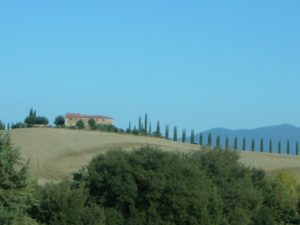 After a much needed refreshing limonata in the Piazza di Santa Maria Novella, we caught our little train back to Florence. An ideal way to end an eventful day – comfortably nestled by a window of a rather dated-looking Tuscan train, which meandered through the Italian countryside, past rocky rivers, babbling brooks, cypress-lined rolling hillsides topped with castellos … picture perfect. With such backdrops for inspiration, no wonder there were so many Italian Masters!
After a much needed refreshing limonata in the Piazza di Santa Maria Novella, we caught our little train back to Florence. An ideal way to end an eventful day – comfortably nestled by a window of a rather dated-looking Tuscan train, which meandered through the Italian countryside, past rocky rivers, babbling brooks, cypress-lined rolling hillsides topped with castellos … picture perfect. With such backdrops for inspiration, no wonder there were so many Italian Masters! 